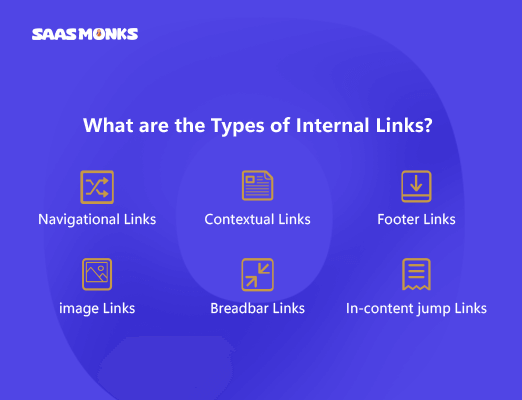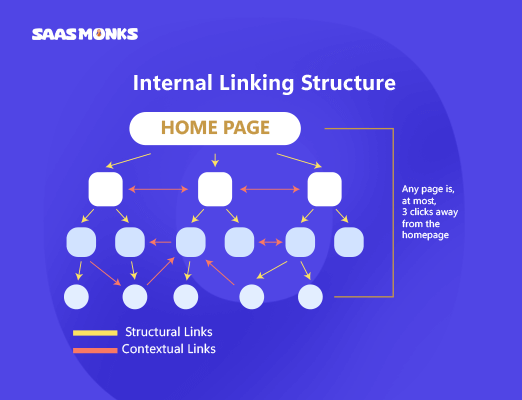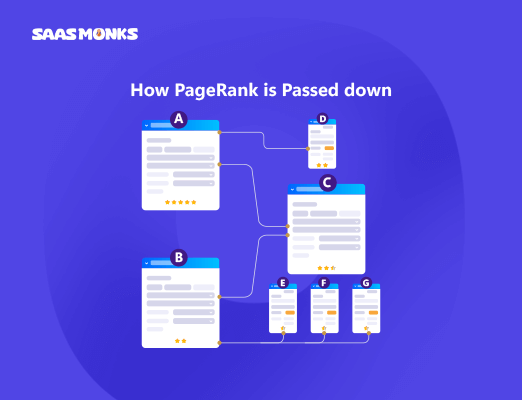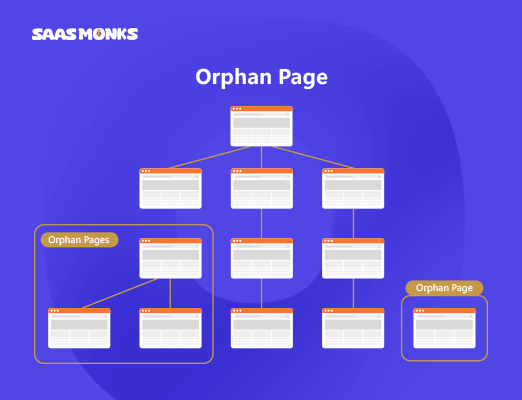Internal links: strategy and best practices
seo
Internal links transform your website from a collection of isolated web pages into a connected ecosystem that search engines understand, crawl efficiently, and rank higher.
In this article, I’ll show you how to design, implement, and audit internal linking for improved rankings, crawl efficiency, and user experience. We’ll cover everything from the fundamentals to advanced techniques that separate amateur SEO efforts from professional strategies.
What are internal links?
Internal links are hyperlinks that connect one page to another page on the same domain.
In practice, internal and external links play distinct roles: internal links pointing between internal pages on the same website help people move across pages on your website, while external links pointing to authoritative pages provide citations and context.
The scope of internal links extends far beyond simple navigation menus. They live in your navigation headers, within your content body, in breadcrumbs, footer sections, and even as clickable images.
Each placement sends different signals and provides varying levels of value to search engines and users. For example, a contextual link within a blog post carries more topical relevance than a generic footer link, while navigational links provide structural clarity that helps search engines understand your site architecture.
Knowing the types of internal links helps you map where each belongs within your website’s structure.
What are the types of internal links?

1. Navigational links
Navigational links form the steady scaffolding of your site architecture. These appear in headers, sidebars, and footers, providing consistent access to your most important pages. They establish clear hierarchies and help both users and search engines understand your site’s primary structure.
2. Contextual links
Contextual links are your most powerful internal linking tool. The same principle that makes contextual link building effective off-site also strengthens relevance when you connect related pages within your site.
These in-body links connect related pages and pass strong topical signals to search engines. When you link from a blog post about “keyword research” to a guide on “long tail keywords,” you’re creating semantic relationships that search engines use to understand content relevance.
3. Breadcrumbs
Breadcrumbs show hierarchical structure and reduce crawl depth to key pages. They provide both navigational value for users and clear structural signals for search engine crawlers, making it easier to understand how pages relate within your site’s organization.
4. Footer links
Footer links should be used sparingly and strategically. Avoid dumping large, unfocused lists of links in your footer, as this can dilute link equity and create poor user experiences.
5. Image links
Image links can be effective when properly implemented. Ensure you use descriptive alt text and provide adjacent anchor context so search engines understand the destination and relevance of the link.
6. In-content jump links
In-content jump links anchor to specific sections within the same page. These are particularly useful for improving user experience on long-form content and help users find specific answers quickly.
Why are internal links important for SEO and users?
Internal links deliver four major outcomes that directly impact your search performance: improved understanding, enhanced discovery, strategic equity flow, and better user experience with higher conversions.
Help search engines understand your site
Internal links reveal relationships and topical clusters that improve how search engines understand your content. When you consistently link related topics together, you create semantic connections that help search algorithms categorize and rank your pages more effectively.
Your internal linking structure tells search engines which pages are most important and how they relate to each other.
A well-organized linking pattern reinforces your website’s structure and makes it easier for algorithms to determine topical authority and content relevance. A strong internal linking structure also surfaces key hubs quickly and supports efficient consolidation of page authority.
Improve crawling and discovery
Links guide search engine crawlers to new pages and prevent orphan pages from being overlooked during indexing. Every internal link creates a pathway for crawlers to follow, ensuring comprehensive coverage of your site’s content.

Keeping crawl depth low to important content enables faster discovery of new pages and updates. When priority pages are accessible within three clicks from your homepage, search engines can find and index them more efficiently, leading to faster ranking improvements.
Distribute link equity
Link value flows through your website via internal links, and strategic linking helps distribute link equity to elevate page authority. High authority pages can pass some of their ranking power to other pages through well-placed internal links.
When your authoritative pages add a reference, they transfer measurable link value that can raise page authority for the target. This equity distribution allows you to strategically boost the ranking potential of specific pages by funneling authority from your strongest content.
It’s like having an internal recommendation system that tells search engines which pages deserve more attention.
Better UX and conversions
Internal links guide users to relevant content and product pages, creating clear pathways for exploration and conversion. When users can easily find related information or next steps, they stay engaged longer and are more likely to complete desired actions.
Strategic link placement can direct users toward high-value pages at the right moments in their journey. A well-timed link to a product page or conversion-focused landing page can significantly impact your bottom line.
What is the solid internal linking strategy (step-by-step)?
Map your site structure and clusters
Start by inventorying your current site structure and defining content clusters by topic. Create a visual representation of how your pages relate to each other and identify gaps in your current linking pattern. Document your website’s internal linking structure so teams can spot missing connections across pages on your site.
Identify related pages within each cluster and outline ideal paths for both users and search engine crawlers. This mapping exercise reveals opportunities for stronger connections and helps prevent orphaned content.
Identify pillar pages
Choose cornerstone pillar pages that deserve more internal links and authority consolidation. These should be your most comprehensive, high-value pages that target primary keywords and serve as authoritative resources in your industry. Favor hubs that already attract links from authoritative pages and can distribute signals to other pages efficiently.
Pillar pages become the hub of your topic clusters, receiving authority from supporting content while passing relevance signals to related pages. They’re typically longer, more comprehensive pieces that could rank for multiple related keywords and accumulate page authority that supports surrounding content.
Create topic clusters and start internal linking
Build hub-and-spoke structures with contextual links between pillar pages and supporting content. Each cluster page should focus on a specific topic area with clear connections between related pieces.
Link supporting articles back to their pillar page and create connections between related supporting articles. This creates a web of relevance that strengthens the entire topic cluster’s authority.
Add contextual links within content
Embed links where they add clarity and depth to your content. Focus on places where additional information would genuinely help readers understand concepts better or take the next steps.
Every internal link should feel natural within the flow of your content and add genuine value.
Use authority pages to pass equity
From your highest-authority pages, strategically point to target pages that need ranking boosts. This might include new content, important product pages, or underperforming pages with good potential.
Monitor which pages have the strongest backlink profiles and highest search engine rankings, then use these as launching points for distributing authority throughout your site.
Support new pages with links
Ensure new pages receive links from recent or high-traffic content immediately after publication. Consider adding links from homepage modules or featured content sections when justified by relevance and value.
New pages without incoming internal links may take weeks or months to be discovered and indexed. Strategic linking from established pages can accelerate this process significantly.
Smart internal linking in taxonomies
Use categories and tags to connect content cluster pages, but avoid excessive cross-linking that dilutes relevance. Taxonomies should enhance organization without creating confusing navigation paths.
Focus on meaningful category relationships and avoid automatic linking systems that create irrelevant connections. Quality and relevance trump quantity in taxonomy linking.
Navigational links done right
Keep header, sidebar, and footer links lean and task-oriented. Don’t duplicate every in-content link in your navigation areas – these serve different purposes and should complement rather than compete with contextual links.
Focus navigation on your most important pages and user pathways. Your website’s structure should be immediately clear from navigation alone.
How often to add internal links?
Add new internal links on publish day for new content, during quarterly content refreshes for existing pages, and after major product launches or site updates that create new linking opportunities.
Regular link addition keeps your internal linking structure fresh and ensures new content integrates properly with your existing topic clusters.
What are internal linking best practices?
1. Link where relevance is high
Add internal links where clear topic overlap exists between the source and destination pages. Avoid generic “read more” chains that don’t provide meaningful connections between content.
Use semantic variants of anchors to avoid over-optimization while maintaining relevance. If your main keyword is “content marketing,” you might also use “content strategy,” “marketing content,” or “content creation” as natural variations.
2. Prioritize contextual links
Do not rely on navigation alone for internal linking. Contextual links within your content are stronger topical signals and provide better user experiences than purely navigational links.
These in-content links carry more weight because they exist within a relevant editorial context. When you naturally reference related topics in your content, contextual links feel organic and provide genuine value to readers.
As part of your internal linking strategy, place links pointing only where they add depth and route to the most relevant pages.
3. Use descriptive anchor text
Descriptive anchor text should clearly indicate what users will find on the linked page. Instead of generic phrases like “click here” or “read more,” use specific, keyword-rich descriptions that include natural long tail keywords where appropriate.
Match the linked page’s intent and ensure the sentence reads naturally; reserve exact-match anchor text for definitive resources and vary phrases elsewhere. If you’re linking to a guide about email marketing automation, use anchor text like “email marketing automation guide” rather than vague references.
Avoid repetitive exact match anchor text for the same destination URL. Vary your anchors with partial matches, branded terms, and semantic variations to maintain a natural linking pattern.
4. Avoid too many internal links
Many internal links on a single page dilute link juice and overwhelm users. Keep pages focused on their primary purpose and include only links that genuinely enhance the user experience.
If a page requires many outbound links, group them logically and use scannable formatting like bulleted lists or clearly defined sections. This maintains usability while preserving the value of each individual link.
5. When to use nofollow internally
Typically, do not use nofollow links for internal linking. You want link equity and discovery benefits to flow throughout your site, so nofollow attributes work against your SEO goals.
Limited exceptions include login-only destinations, duplicate filtered URLs, or temporary gateways where you don’t want to pass authority or encourage indexing.
6. Don’t link to pages blocked by robots/meta robots
Ensure all linked pages are crawlable and indexable. Avoid linking to pages marked with noindex tags, blocked by robots.txt, or otherwise restricted from search engine access. These links waste crawl budget and provide no SEO value.
7. Follow anchor text patterns that look natural
Branded anchors include your company or product name: “SaaSMonks internal linking guide” or “Mailchimp email templates.”
Partial-match anchors include portions of your target keywords: “link equity distribution tips” when targeting “internal link equity.”
Phrase-match anchors use natural language that includes target keywords: “how to audit internal links effectively.”
Semantic variants use related terms and synonyms: “site architecture optimization” or “topic cluster development.”
8. Maintain link placement hygiene
Prefer earlier placement in your content when links improve task completion, but avoid pushing users off the page too soon. The key is timing – provide value first, then offer relevant next steps.
Avoid multiple identical anchors pointing to the same URL within one web page. Choose the best single instance and remove duplicates to maintain a clean link structure.
Risk checks: Monitor for pages with too many links, orphan pages with no incoming links, thin pages that don’t warrant multiple links, duplicate anchors to the same URL, and incoming internal links imbalances where important pages receive insufficient link equity. During audits, proactively identify broken links and fix broken internal links to restore pathways.
Advanced internal linking techniques (high-value, expert-level)
Model internal PageRank

Use internal PageRank simulations or link graph analysis to identify where adding links will create the biggest authority lift. Understanding how link equity flows through your site enables more strategic linking decisions.
Focus link equity from high-authority pages toward target pages that need ranking boosts. This modeling approach helps prioritize linking efforts for maximum SEO impact.
Entity-led internal linking
Organize content clusters around entities and their attributes rather than just keywords. Use anchor text that reflects entity names, variants, and relationships to help search engines understand context and semantic connections.
This approach aligns with how modern search algorithms understand content through entities and knowledge graphs rather than simple keyword matching.
Optimize for AI Overviews and AEO
Structure content with answer-first sections that link to definitive subtopics. Ensure contextual links connect to supporting evidence, FAQs, and detailed explanations that can surface in AI-powered search features.
Create clear information hierarchies that AI systems can easily parse and reference, with strategic links to comprehensive supporting content.
Safe automation rules at scale
Implement rule-based internal linking suggestions using AI SEO tools, but always include human review to avoid spammy exact-match anchors and irrelevant placements. Define clear guardrails for automated systems to prevent over-optimization.
Automate internal linking discovery and suggestions, but maintain editorial control over implementation to ensure relevance and natural language flow.
Facets and pagination without traps
Canonicalize filtered URLs appropriately and link only to key facet combinations that provide genuine value. Add “view all” options or curated hub pages to avoid creating crawl traps in e-commerce or content sites.
Design pagination and filtering systems that enhance rather than complicate your internal linking structure.
E-commerce linking patterns
Link from category pages to best-selling products and evergreen buying guides. From product pages, connect to sizing guides, care instructions, comparison tools, and related or complementary items.
Create clear pathways from informational content to commercial pages without being overly promotional, and add more links only when a new connection genuinely helps the task. Focus on genuinely helpful connections that serve user intent.
International and hreflang linking
Cross-link language and regional variants appropriately while ensuring users and crawlers can easily reach the correct locale version. Maintain clear hreflang implementation alongside strategic internal linking.
Consider how internal linking patterns may need to vary across different international markets and user behaviors.
Docs and knowledge base chains
Use section anchors and heading-level links for precise cross-references in long-form documentation. Where your system allows, implement block-level linking for granular navigation within comprehensive guides.
Design documentation internal linking to support both linear reading and topic-based exploration patterns that match how users actually consume technical content. Track outcomes from these internal linking efforts and iterate when data shows readers still bounce before finding the right destination.
Auditing your internal links (find & fix issues)
Identify broken internal links and internal redirects
Fix broken links immediately – they waste crawl budget and create poor user experiences. Replace internal links that hit redirects with direct links to final destinations to preserve link equity and improve site speed.
Use tools like Screaming Frog or Google Search Console to identify 404 errors and redirect chainslightweight SEO Chrome extensions can also flag missing or broken links during spot checks. Prioritize fixes for high-authority pages and important user pathways.
Spot orphan pages and pages with one incoming link

Add contextual links from relevant pages to underlinked or orphaned content; simple Google search operators (like site: and inurl:) can quickly reveal candidates. Pages with only one incoming link are often underutilized opportunities for better integration.
Review your content inventory regularly to identify valuable pages that aren’t receiving appropriate internal link support. These pages may have good content, but poor discoverability.
Reduce crawl depth to key pages
Aim for important pages to be accessible within three clicks from your homepage. Add strategic shortcuts from strong hub pages to reduce the clicks required to reach priority content.
Deep pages often receive less crawl attention and authority. Bringing important content closer to your homepage through strategic linking can improve its ranking potential.
Fix mixed protocols and canonicals
Ensure HTTPS consistency throughout your internal links and verify that canonical tags point to the correct versions so search engine results pages consolidate signals correctly. Mixed protocols, split link equity, and confuse search engines about your preferred page versions.
Audit your site for HTTP links that should point to HTTPS versions, and ensure all internal links follow consistent URL structures.
Avoid unparseable or blocked links
Keep internal links in standard HTML format that search engines can easily parse. Avoid links hidden behind JavaScript or within search boxes that may not be discoverable by crawlers.
Ensure your most important internal links are in plain HTML anchor tags that require no special rendering or user interaction to access.
Detect link overload on a page
Evaluate how many internal links each page truly needs. Pages with excessive outbound links may dilute their link equity and overwhelm users with choices.
Consolidate clusters of related links and remove duplicates. Focus on the most valuable connections rather than trying to link to everything possible.
How SaaSMonks can help you ship a solid internal linking strategy?
If your internal linking plan feels complex or time-consuming, a short, focused SEO consultation can help you move faster with fewer guesswork loops.
What you’ll receive: a practical internal link audit, a clear map of your current site architecture, and a prioritized linking roadmap for pillar pages, content clusters, and quick wins your team can implement.
Who it suits: sites with lots of existing content, new pages that need links to be discovered, or flat structures that would benefit from clearer hierarchy and shorter click paths.
How we work: we review real user paths and crawler access, surface bottlenecks (like orphan pages, deep click depth, and redirect chains), and recommend specific placements with example anchor patterns. You can execute in-house, or we can pair with your team – whatever’s easiest.
What to expect: cleaner navigation for users and crawlers, faster discovery of new content, and clearer signals to support rankings. We’ll also suggest simple KPIs so you can track the impact over time.
If that sounds useful, we’re happy to chat and see whether this is a good fit for your goals.
Conclusion
Internal links improve search engine understanding, content discovery, link equity flow, and user experience when implemented contextually and audited regularly. The key is treating internal linking as a strategic discipline rather than an afterthought.
Start with a step-by-step rollout: map your current structure, identify and strengthen topic clusters, support new content with strategic links, conduct quarterly audits, and gradually layer in advanced techniques as your site grows.
Remember that an effective internal linking strategy isn’t about adding more links – it’s about adding the right links in the right places to create genuine value for users while sending clear signals to search engines about your content’s relevance and authority.

